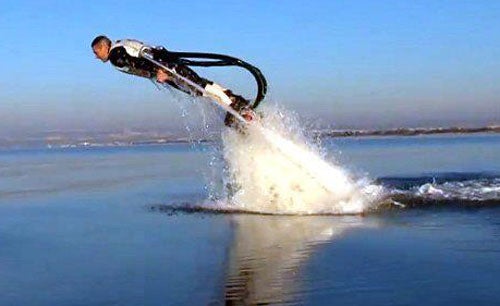PWC-Propelled Jet Packs Taking Off…Literally
Fly through the air with the power of your PWC
Apparently lots of people like the idea of flying like Ironman, or whizzing atop the earth like a character out of Lost in Space. Personal jetpacks are suddenly all the rage, showing up everywhere from YouTube videos to waterfront resorts. But unlike those packs of movies and television, these modern-day rocket packs are using something very familiar for their propulsion – the same jet of water that propels your personal watercraft.
First on the scene was the JetLev, a backpack-style contraption that closely resembled that jet pack from Lost In Space, but used water, fed from essentially a driver-less PWC below, to provide the lift. It’s undoubtedly cool, but you’d better have some extra cash on hand should you want to buy one. The price tag is about $100,000. That makes the latest two products on the market, the FlyBoard (about $6,500) and the Jetovator (about $9,000), all the more appealing.
 JetLev was the first water-powered jetpack on the scene, but its cost is prohibitive.
JetLev was the first water-powered jetpack on the scene, but its cost is prohibitive.For starters, both products literally use your PWC, not some modified one-off. That means you can ride your craft one minute, and convert it to flyboy use the next, without shelling out the additional cash for a one-trick-pony that just supplies the water. Both products link the flyer to the PWC via a 40-foot hose, which attaches to the PWC via a U-shaped pipe that bolts in place of your jet pump. Connecting or converting your PWC back to normal use requires less than 30 minutes and minimal mechanical ability.
Designed by French PWC racer Franky Zapata, FlyBoard’s approach is to attach the rider to a small, wakeboard-like plastic board. Cast-iron jets, attached below the board’s surface, provide the upward lift, using about 90% of the delivered thrust. The remaining 10% is channeled to aluminum thrusters in the rider’s hands. Riders “fly” the board by shifting their body weight and using the hand-mounted thrusters for added control.
 The Flyboard is a much more affordable option.
The Flyboard is a much more affordable option.In standard trim, the FlyBoard gives the pilot no control of how much thrust is delivered. That’s the job of the PWC driver, who handles the throttle. Many buyers will likely opt for the optional Electronic Management Kit ($1,850), which gives the flyer a trigger throttle, linked electronically via cable to the PWC below.
 Flyboard riders are strapped to a wakeboard-style contraption.
Flyboard riders are strapped to a wakeboard-style contraption.The Jetovator takes a slightly different approach. Rather than a backpack or board, its jet-propelled vehicle looks more like a sport bike, or one of those things Luke and Leah rode in The Empire Strikes Back. The unit’s fiberglass, main body features a padded saddle and nose. A primary nozzle, located just forward of the foot pegs, provides straight-line thrust. Handlebars, which extend forward similar to a triathlete or time trialist’s bicycle, control the angle of thrust provided by two additional jet nozzles. Pivoting the handlebars up and down controls the direction of the thrust, enabling the Jetovator to fly across the water in a straight line, or rocket up into the air. Body English controls motion to the left or right.
 The Jetovator takes a different approach, opting for a motorcycle-style body.
The Jetovator takes a different approach, opting for a motorcycle-style body.Like the stock FlyBoard, riding the Jetovator is a two-person event. A passenger is required aboard the PWC to control the throttle, and in turn just how much thrust is delivered to your water-propelled crotch rocket. Jetovator is currently working on an electronic link to the PWC below so that pilots can fly at their own pace.
Both products also require a mandatory “flying” lesson, but promise riders will be up and running in less than an hour.
For more information…
http://www.flyboard.com/
http://www.jetovator.com/
Related Reading
PWC-Powered Water Bike Making Waves – Video
Get PersonalWatercraft.com in your Inbox!
Like PersonalWatercraft.com on Facebook
Comments
Most Popular

2025 Yamaha JetBlaster PRO 2-Up Review

2024 Kawasaki Jet Ski STX 160X Review

Remembering the Sea-Doo XP

Whatever Happened to the Wetbike?

2025 Yamaha JetBlaster Review











 Your Privacy Choices
Your Privacy Choices